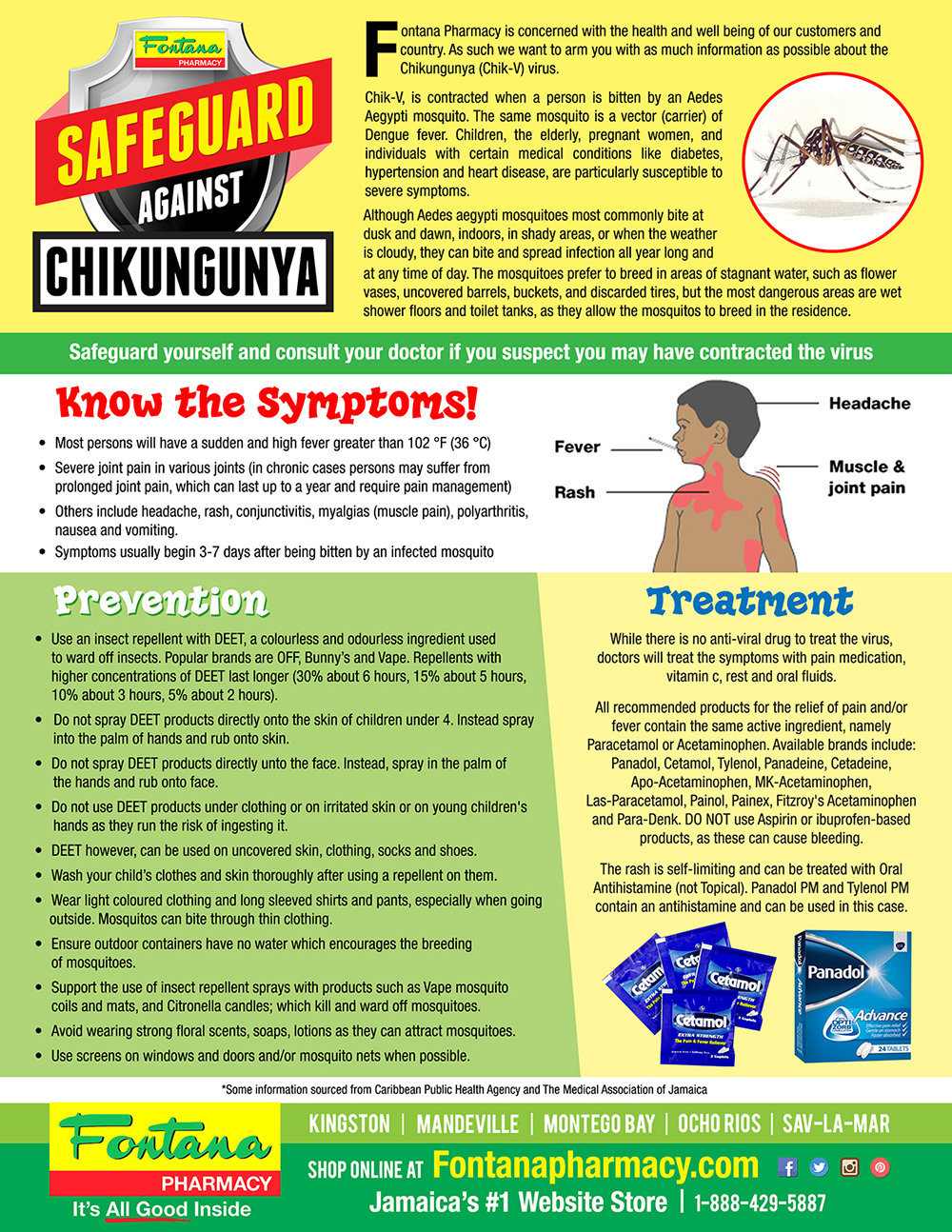 Loading... Please wait...
Loading... Please wait...
Already have an account?
Login to check loyalty balance or redeem rewards
- Home
- Blog
BLOG
Safeguard Against Chikungunya
Posted on 1st Oct 2014 @ 11:28 AM
Fontana Pharmacy is concerned with the health and wellbeing of our customers and country. As such we want to arm you with as much information as possible about the Chikungunya (Chik-V) virus.
Chik-V, is contracted when a person is bitten by an Aedes Aegypti mosquito. The same mosquito is a vector (carrier) of Dengue fever. Children, the elderly, pregnant women, and individuals with certain medical conditions like diabetes, hypertension and heart disease, are particularly susceptible to severe symptoms.
Although Aedes aegypti mosquitoes most commonly bite at dusk and dawn, indoors, in shady areas, or when the weather is cloudy, they can bite and spread infection all year long and at any time of day. The mosquitoes prefer to breed in areas of stagnant water, such as flower vases, uncovered barrels, buckets, and discarded tires, but the most dangerous areas are wet shower floors and toilet tanks, as they allow the mosquitos to breed in the residence.
Safeguard yourself and consult your doctor if you suspect you may have contracted the virus
- Most persons will have a sudden and high fever greater than 102 °F (36 °C)
- Severe joint pain in various joints (in chronic cases persons may suffer from prolonged joint pain, which can last up to a year and require pain management)
- Others include headache, rash, conjunctivitis, myalgias (muscle pain), polyarthritis, nausea and vomiting.
- Symptoms usually begin 3-7 days after being bitten by an infected mosquito
Know the Symptoms!
- Use an insect repellent with DEET, a colourless and odourless ingredient used to ward off insects. Popular brands are OFF, Bunny’s and Vape. Repellents with
- higher concentrations of DEET last longer (30% about 6 hours, 15% about 5 hours,10% about 3 hours, 5% about 2 hours).
- Do not spray DEET products directly onto the skin of children under 4. Instead spray into the palm of hands and rub onto skin.
- Do not spray DEET products directly unto the face. Instead, spray in the palm of the hands and rub onto face.
- Do not use DEET products under clothing or on irritated skin or on young children's hands as they run the risk of ingesting it.
- DEET however, can be used on uncovered skin, clothing, socks and shoes.
- Wash your child’s clothes and skin thoroughly after using a repellent on them.
- Wear light coloured clothing and long sleeved shirts and pants, especially when going outside. Mosquitos can bite through thin clothing.
- Ensure outdoor containers have no water which encourages the breeding of mosquitoes.
- Support the use of insect repellent sprays with products such as Vape mosquito coils and mats, and Citronella candles; which kill and ward off mosquitoes.
- Avoid wearing strong floral scents, soaps, lotions as they can attract mosquitoes.
Prevention
*Some information sourced from Caribbean Public Health Agency and The Medical Association of Jamaica
All recommended products for the relief of pain and/or fever contain the same active ingredient, namely, Paracetamol or Acetaminophen. Available brands include: Panadol, Cetamol, Tylenol, Panadeine, Cetadeine, Apo-Acetaminophen, MK-Acetaminophen, Las-Paracetamol, Painol, Painex, Fitzroy's Acetaminophen
and Para-Denk. DO NOT use Aspirin or ibuprofen-based products, as these can cause bleeding.The rash is self-limiting and can be treated with Oral
Antihistamine (not Topical). Panadol PM and Tylenol PM contain an antihistamine and can be used in this case.
Treatment
All recommended products for the relief of pain and/or fever contain the same active ingredient, namely Paracetamol or Acetaminophen. Available brands include:
Panadol, Cetamol, Tylenol, Panadeine, Cetadeine, Apo-Acetaminophen, MK-Acetaminophen, Las-Paracetamol, Painol, Painex, Fitzroy's Acetaminophen and Para-Denk. DO NOT use Aspirin or ibuprofen-based products, as these can cause bleeding. The rash is self-limiting and can be treated with Oral Antihistamine (not Topical). Panadol PM and Tylenol PM contain an antihistamine and can be used in this case.
History of Chikungunya
The disease was first was first detected in 1952 in Africa following an outbreak on the Makonde Plateau. This is a border area between Mozambique and Tanzania. The virus was isolated from the serum of a febrile patient from this area. The name chikungunya is derived from the Makonde word meaning "that which bends up" in reference to the stooped posture developed as a result of the arthritic symptoms of the disease. In Swahili this means "the illness of the bended walker”. Makonde is the language spoken by the Makonde, an ethnic group in southeast Tanzania and northern Mozambique.
According to the initial 1955 report about the epidemiology of the disease, the term 'chikungunya' is derived from the Makonde root verb kungunyala, meaning to dry up or become contorted. The Makonde term was more specifically referred to as "that which bends up". Subsequent authors apparently overlooked the references to the Makonde language and assumed that the term derived from Swahili, the lingua franca of the region. The erroneous attribution of the term as a Swahili word has been repeated in numerous print sources. Many other erroneous spellings and forms of the term are in common use including "Chicken guinea", "Chicken gunaya," and "Chickengunya".
Chikungunya virus (CHIKV) likely originated in Central/East Africa, where the virus has been found to circulate in a sylvatic cycle between forest-dwelling mosquitoes and nonhuman primates. In these areas, sporadic human cases occur, but large human outbreaks were not common. However, in urban centers of Africa as well as throughout Asia, the virus can circulate between mosquitoes and naive human hosts in a cycle similar to that of dengue viruses.
Since its discovery in Africa, in 1952, chikungunya virus outbreaks have occurred occasionally, but recent outbreaks have spread the disease to other parts of the world. Numerous chikungunya re-emergences have been documented in Africa, Asia (India), and Europe, with irregular intervals of 2–20 years between outbreaks. Currently, chikungunya fever has been identified in nearly 40 countries. In 2008, chikungunya was listed as a US National Institute of Allergy and Infectious Diseases (NIAID) category C priority pathogen.








